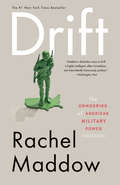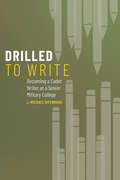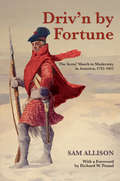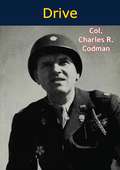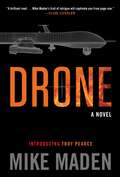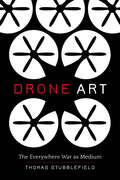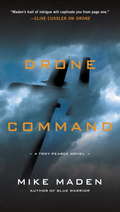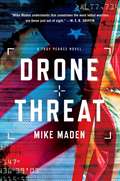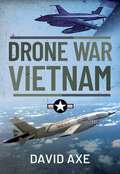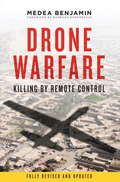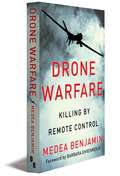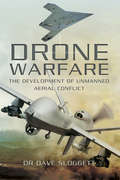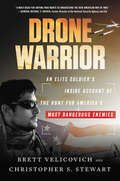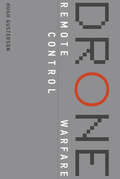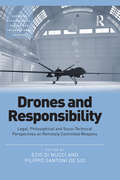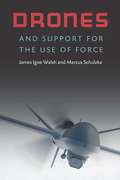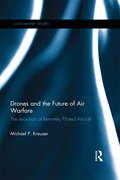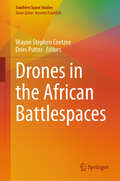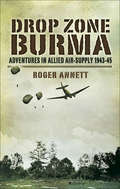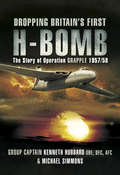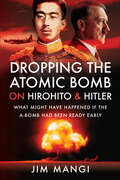- Table View
- List View
Drift: The Unmooring of American Military Power (Playaway Adult Nonfiction Ser.)
by Rachel MaddowThe #1 New York Times bestseller that charts America’s dangerous drift into a state of perpetual war. Written with bracing wit and intelligence, Rachel Maddow's Drift argues that we've drifted away from America's original ideals and become a nation weirdly at peace with perpetual war. To understand how we've arrived at such a dangerous place, Maddow takes us from the Vietnam War to today's war in Afghanistan, along the way exploring Reagan's radical presidency, the disturbing rise of executive authority, the gradual outsourcing of our war-making capabilities to private companies, the plummeting percentage of American families whose children fight our constant wars for us, and even the changing fortunes of G.I. Joe. Ultimately, she shows us just how much we stand to lose by allowing the scope of American military power to overpower our political discourse. Sensible yet provocative, dead serious yet seriously funny, Drift will reinvigorate a "loud and jangly" political debate about our vast and confounding national security state.
Drilled to Write: Becoming a Cadet Writer at a Senior Military College
by J. Michael RifenburgDrilled to Write offers a rich account of US Army cadets navigating the unique demands of Army writing at a senior military college. In this longitudinal case study, J. Michael Rifenburg follows one cadet, Logan Blackwell, for four years and traces how he conceptualizes Army writing and Army genres through immersion in military science classes, tactical exercises in the Appalachian Mountains, and specialized programs like Airborne School. Drawing from research on rhetorical genre studies, writing transfer, and materiality, Drilled to Write speaks to scholars in writing studies committed to capturing how students understand their own writing development. Collectively, these chapters articulate four ways Blackwell leveraged resources through ROTC to become a cadet writer at this military college. Each chapter is dedicated to one year of his undergraduate experience with focus on curricular writing for his business management major and military science classes as well as his extracurricular writing, like his Ballroom Dance Club bylaws and a three-thousand-word short story. In Drilled to Write, Rifenburg invites readers to see how cadets are positioned between civilian and military life—a curiously liminal space where they develop as writers. Using Army ROTC as an entry into genre theory and larger conversations about the role higher education plays in developing Army officers, he shows how writing students develop genre awareness and flexibility while forging a personal identity.
Driv'n by Fortune: The Scots' March to Modernity in America, 1745–1812
by Sam AllisonA provocative account of the 78th Fraser’s Highlanders and its crucial place in history. The remarkable story of the men of the 78th Fraser’s Highlanders moves from the 1745 Jacobite Rebellion in Scotland, through the Seven Years’ War and the American Revolution, to the War of 1812. Simon Fraser, chief of the Clan Fraser of Lovat, raised the 78th Highlanders, a regiment that played a major role in defeating the French on the Plains of Abraham. Driv’n by Fortune tackles the myths embedded in nationalistic history and in fictional accounts of these Highland soldier-settlers who brought the Scottish Enlightenment to North America. The impact of the 78th Fraser’s Highlanders, which extended far beyond Scotland and the Canada of their times, is finally being told.
Drive
by Col. Charles R. CodmanHaving fought with distinction (winning the Silver Star and the Croix de Guerre) in the First World War as a pilot, Charles Russell Codman retired back to civilian life believing that his fighting days were over. However he re-entered the army to fight on the side of Democracy once again, and before long his unique qualifications led him to being appointed as aide-de-camp to no lesser general than George S. Patton Jr. This book is the fascinating story of Codman's experiences as part of General Patton's staff from the sands of North Africa to eventual victory in Germany. A rare insight into the wartime career at the headquarters of America's finest fighting general of the Second World War."THIS book is compiled from letters written to my wife during thirty-three months of service (1942-1945) in the European theater of operations during World War II."At the end of the North African campaign, I was appointed A.D.C. to General George S. Patton, Jr., serving from then on as his senior aide-de-camp until after V-E Day and his return to the United States. While General Patton is naturally the central and dominating figure of this journal, the latter is in no sense an attempt at either biography or military analysis."--The Author
Driven Patriot
by Douglas Brinkley Townsend HoopesA biography of the brilliant, ambitious Forrestal whose career took him from the Wall Street to Washington.
Drone (A Troy Pearce Novel #1)
by Mike Maden"A brilliant read with astounding plot twists. . . Maden's trail of intrigue will captivate you from page one. " -CLIVE CUSSLER With a fascinating international cast of characters and nonstop action, Mike Maden’s Drone kicks off an explosive new thriller series exploring the inescapable consequences of drone warfare. Troy Pearce is the CEO of Pearce Systems, a private security firm that is the best in the world at drone technologies. A former CIA SOG operative, Pearce used his intelligence and combat skills to hunt down America’s sworn enemies in the War on Terror. But after a decade of clandestine special ops, Pearce opted out. Too many of his friends had been sacrificed on the altar of political expediency. Now Pearce and his team chose which battles he will take on by deploying his land, sea, and air drones with surgical precision. Pearce thinks he’s done with the U. S. government for good, until a pair of drug cartel hit men assault a group of American students on American soil. New U. S. president Margaret Meyers then secretly authorizes Pearce Systems to locate and destroy the killers sheltered in Mexico. Pearce and his team go to work, and they are soon thrust into a showdown with the hidden powers behind the El Paso attack-unleashing a host of unexpected repercussions. A Ph. D. , lecturer, and consultant on political science and international conflict, Mike Maden has crafted an intense, page-turning novel that is action-packed and frighteningly real-blurring the lines between fiction and the reality of a new stage in warfare. .
Drone Art: The Everywhere War as Medium
by Thomas StubblefieldWhat happens when a drone enters a gallery or appears on screen? What thresholds are crossed as this weapon of war occupies everyday visual culture? These questions have appeared with increasing regularity since the advent of the War on Terror, when drones began migrating into civilian platforms of film, photography, installation, sculpture, performance art, and theater. In this groundbreaking study, Thomas Stubblefield attempts not only to define the emerging genre of "drone art" but to outline its primary features, identify its historical lineages, and assess its political aspirations. Richly detailed and politically salient, this book is the first comprehensive analysis of the intersections between drones, art, technology, and power.
Drone Command
by Mike MadenTroy Pearce and his elite team of drone experts are called in when rising tensions between China and Japan threaten to dramatically change the geopolitical climate of the world. When China stakes a dubious claim in the hotly disputed waters of the East China Sea, the prime minister of Japan threatens to dispatch the country's naval assets and tear up its antiwar constitution unless the Americans forcefully intervene. The war-weary Americans are reluctant to confront the powerful Chinese navy directly, but if the Japanese provoke a military conflict with their historic enemy, treaty obligations would draw the United States into the fight. In order to deescalate the first foreign policy crisis of his administration, U.S. president Lane dispatches Troy Pearce and his team to Tokyo to defuse the situation. What they find is a quagmire of hawkish politicians, nationalistic fervor, special interests with their own hidden agendas, and possibly the greatest military threat that America has ever faced. In this treacherous atmosphere it will require all of Pearce's cunning--and his team's technological prowess--to separate the truth from misdirection, and prevent the world from plunging into war.From the Hardcover edition.
Drone Threat (A Troy Pearce Novel #4)
by Mike MadenTroy Pearce and his team of drone experts are called to action when ISIS launches a series of attacks on U.S. soil. On the eve of President Lane's historic Asian Security Summit, a hobby-store quadcopter lands on the White House lawn carrying a package and an ominous threat: Fly the enclosed black flag of ISIS over the White House by noon today or suffer the consequences. The threat further promises that every day the flag isn't flown a new attack will be launched, each deadlier than the first. President Lane refuses to comply with the outrageous demand, but the first drone attacks, sending a shudder through the U.S. economy. With few options available and even fewer clues, President Lane unleashes Troy Pearce and his Drone Command team to find and stop the untraceable source of the destabilizing attacks. But the terror mastermind proves more elusive and vindictive than any opponent Pearce has faced before . . . and if Pearce fails, the nation will suffer an unimaginable catastrophe on its soil or be forced into war.
Drone War Vietnam
by David AxeWhile the use of drones is now commonplace in modern warfare, it was in its infancy during the Vietnam War, not to mention revolutionary and top secret. Drones would play an important – and today largely unheralded – role in the bloody, two-decade US air war over Vietnam and surrounding countries in the 1960s and ’70s. Drone aircraft spotted targets for manned US bombers, jammed North Vietnamese radars and scattered propaganda leaflets, among other missions. This book explores that obscure chapter of history. DRONE WAR: VIETNAM is based on military records, official histories and published first-hand accounts from early drone operators, as well as on a close survey of existing scholarship on the topic. In their fledgling efforts to send robots instead of human beings on the most dangerous aerial missions, US operators in South-East Asia in the 1960s and ’70s wrote the first chapter in the continuing tale of autonomous warfare.
Drone Warfare
by Barbara Ehrenreich Medea BenjaminDrone Warfare is the first comprehensive analysis of one of the fastest growing--and most secretive--fronts in global conflict: the rise of robot warfare. In 2000, the Pentagon had fewer than fifty aerial drones; ten years later, it had a fleet of nearly 7,500, and the US Air Force now trains more drone "pilots" than bomber and fighter pilots combined. Drones are already a $5 billion business in the US alone. The human cost? Drone strikes have killed more than 200 children alone in Pakistan and Yemen.CODEPINK and Global Exchange cofounder Medea Benjamin provides the first extensive analysis of who is producing the drones, where they are being used, who controls these unmanned planes, and what are the legal and moral implications of their use. In vivid, readable style, this book also looks at what activists, lawyers, and scientists across the globe are doing to ground these weapons. Benjamin argues that the assassinations we are carrying out from the air will come back to haunt us when others start doing the same thing--to us.
Drone Warfare: Killing by Remote Control
by Barbara Ehrenreich Medea BenjaminWeeks after the 2002 American invasion of Afghanistan, Medea Benjamin visited that country. There, on the ground, talking with victims of the strikes, she learned the reality behind the "precision bombs" on which U. S. forces were becoming increasingly reliant. Now, with the use of drones escalating at a meteoric pace, Benjamin has written this book as a call to action: "It is meant to wake a sleeping public," she writes, "lulled into thinking that drones are good, that targeted killings are making us safer. " Drone Warfare is a comprehensive look at the growing menace of robotic warfare, with an extensive analysis of who is producing the drones, where they are being used, who "pilots" these unmanned planes, who are the victims and what are the legal and moral implications. In vivid, readable style, the book also looks at what activists, lawyers and scientists are doing to ground the drones, and ways to move forward. In reality, writes Benjamin, the assassinations we are carrying out via drones will come back to haunt us when others start doing the same thing--to us.
Drone Warfare: The Development of Unmanned Aerial Conflict
by Dr. Dave SloggettThe Development of Unmanned Aerial Conflict will examine the development and use of aerial drones, a topical subject that has not been written on to date.An unmanned aerial vehicle, commonly known as a drone, is an aircraft without a human pilot on board. Its flight is either controlled autonomously by computers in the vehicle, or under the remote control of a navigator or pilot on the ground or in another vehicle.Blending history with current and recent operations, Dr Sloggett will set out to put the record straight. In some quarters of the press drones get a bad press and there has been much controversy over their deployment, some of which is not deserved.The book reveals the history of unmanned aircraft, their recent development and why they have emerged onto the scene. Why did the US, for example, really invest highly in drone technology? When did all that start? What barriers had to be overcome? What was there before drones arrived?The book also analyses their operations in Iraq in Gulf War Two and more recently Afghanistan. What roles did drones play? Where they successful? What new developments emerged during operations? Did they save lives? Further to this is a detailed look at case studies where they have been used trying to remove some of the incorrect reporting – putting the record straight based on evidence. How many have been shot down and where?The book then looks at strategic uses of drones at present: Iran is being monitored; they are already in action over parts of Africa; what are other countries doing – China, Iran? Turkey?The RAF's use of drones, their deployment and operations is considered along with important questions such as where this goes for the future. What are the issues? Will all air forces be drone based in the future? What other applications may arise in the civilian market?
Drone Warrior: An Elite Soldier's Inside Account of the Hunt for America's Most Dangerous Enemies
by Christopher S. Stewart Brett VelicovichA former U.S. Army intelligence and special ops soldier gives a look inside some of the nation’s most secretive military operations.For nearly a decade, Brett Velicovich was at the center of America’s new generation of warfare: an arsenal of unmanned aerial vehicles—drones—taking down the world’s deadliest terrorists across the globe. Now this decorated veteran, with journalist Christopher S. Stewart, tells his story in a remarkable book packed with more classified drone operations cleared for public release than any other account ever published, according to the U.S. government. Drone Warrior offers an unprecedented view into the remarkably complex nature of drone missions in the hottest conflict zones today and the rigorous and wrenching on-the-ground decisions behind them.Drone Warrior also chronicles the U.S. military’s evolution in the past decade and the technology driving it. Velicovich considers the future it foretells, and speaks candidly on the physical and psychological toll it exacts, including the impact his missions had on his own life. He reminds us that while these machines can kill, they can also be used to preserve life, including protecting endangered species and supporting humanitarian operations—work he is engaged in today.
Drone Wars
by Peter L. Bergen Daniel RothenbergDrones are the iconic military technology of many of today's most pressing conflicts. Drones have captured the public imagination, partly because they project lethal force in a manner that challenges accepted norms and moral understandings. Drone Wars presents a series of essays by legal scholars, journalists, government officials, military analysts, social scientists, and foreign policy experts. It addresses drones' impact on the ground, how their use adheres to and challenges the laws of war, their relationship to complex policy challenges, and the ways they help us understand the future of war. The book is a diverse and comprehensive interdisciplinary perspective on drones that covers important debates on targeted killing and civilian casualties, presents key data on drone deployment, and offers new ideas on their historical development, significance, and impact on law and policy.
Drone: Remote Control Warfare
by Hugh GustersonDrones are changing the conduct of war. Deployed at presidential discretion, they can be used in regular war zones or to kill people in such countries as Yemen and Somalia, where the United States is not officially at war. Advocates say that drones are more precise than conventional bombers, allowing warfare with minimal civilian deaths while keeping American pilots out of harm's way. Critics say that drones are cowardly and that they often kill innocent civilians while terrorizing entire villages on the ground. In this book, Hugh Gusterson explores the significance of drone warfare from multiple perspectives, drawing on accounts by drone operators, victims of drone attacks, anti-drone activists, human rights activists, international lawyers, journalists, military thinkers, and academic experts. Gusterson examines the way drone warfare has created commuter warriors and redefined the space of the battlefield. He looks at the paradoxical mix of closeness and distance involved in remote killing: is it easier than killing someone on the physical battlefield if you have to watch onscreen? He suggests a new way of understanding the debate over civilian casualties of drone attacks. He maps "ethical slippage" over time in the Obama administration's targeting practices. And he contrasts Obama administration officials' legal justification of drone attacks with arguments by international lawyers and NGOs.
Drone: Remote Control Warfare
by Hugh GustersonDrone warfare described from the perspectives of drone operators, victims of drone attacks, anti-drone activists, international law, military thinkers, and others. Drones are changing the conduct of war. Deployed at presidential discretion, they can be used in regular war zones or to kill people in such countries as Yemen and Somalia, where the United States is not officially at war. Advocates say that drones are more precise than conventional bombers, allowing warfare with minimal civilian deaths while keeping American pilots out of harm's way. Critics say that drones are cowardly and that they often kill innocent civilians while terrorizing entire villages on the ground. In this book, Hugh Gusterson explores the significance of drone warfare from multiple perspectives, drawing on accounts by drone operators, victims of drone attacks, anti-drone activists, human rights activists, international lawyers, journalists, military thinkers, and academic experts.Gusterson examines the way drone warfare has created commuter warriors and redefined the space of the battlefield. He looks at the paradoxical mix of closeness and distance involved in remote killing: is it easier than killing someone on the physical battlefield if you have to watch onscreen? He suggests a new way of understanding the debate over civilian casualties of drone attacks. He maps “ethical slippage” over time in the Obama administration's targeting practices. And he contrasts Obama administration officials' legal justification of drone attacks with arguments by international lawyers and NGOs.
Drones and Responsibility: Legal, Philosophical and Socio-Technical Perspectives on Remotely Controlled Weapons (Emerging Technologies, Ethics and International Affairs)
by Ezio Di Nucci Filippo Santoni SioHow does the use of military drones affect the legal, political, and moral responsibility of different actors involved in their deployment and design? This volume offers a fresh contribution to the ethics of drone warfare by providing, for the first time, a systematic interdisciplinary discussion of different responsibility issues raised by military drones. The book discusses four main sets of questions: First, from a legal point of view, we analyse the ways in which the use of drones makes the attribution of criminal responsibility to individuals for war crimes more complicated and what adjustments may be required in international criminal law and in military practices to avoid ’responsibility gaps’ in warfare. From a moral and political perspective, the volume looks at the conditions under which the use of military drones by states is impermissible, permissible, or even obligatory and what the responsibilities of a state in the use of drones towards both its citizens and potential targets are. From a socio-technical perspective, what kind of new human machine interaction might (and should) drones bring and which new kinds of shared agency and responsibility? Finally, we ask how the use of drones changes our conception of agency and responsibility. The book will be of interest to scholars and students in (military) ethics and to those in law, politics and the military involved in the design, deployment and evaluation of military drones.
Drones and Support for the Use of Force
by Marcus Schulzke James Igoe WalshCombat drones are transforming attitudes about the use of military force. Military casualties and the costs of conflict sap public support for war and for political and military leaders. Combat drones offer an unprecedented ability to reduce these costs by increasing accuracy, reducing the risks to civilians, and protecting military personnel from harm. These advantages should make drone strikes more popular than operations involving ground troops. Yet many critics believe drone warfare will make political leaders too willing to authorize wars, weakening constraints on the use of force. Because combat drones are relatively new, these arguments have been based on anecdotes, a handful of public opinion polls, or theoretical speculation. Drones and Support for the Use of Force uses experimental research to analyze the effects of combat drones on Americans’ support for the use of force. The authors’ findings—that drones have had important but nuanced effects on support for the use of force—have implications for democratic control of military action and civil-military relations and provide insight into how the proliferation of military technologies influences foreign policy.
Drones and the Future of Air Warfare: The Evolution of Remotely Piloted Aircraft (Cass Military Studies)
by Michael P. KreuzerThis book examines the evolution of airpower and specifically the growth and proliferation of Remotely Piloted Aircraft (RPAs). While most existing literature examines either the law or ethics of RPAs, and some newer scholarship looks to the battlefield effectiveness (the gains from strikes versus the potential for ‘blowback, etc.), this work investigates it from a broader military perspective. It examines the strategy for employment of RPAs across the spectrum of warfare, the potential deterrent value of RPAs in some circumstances, and the resulting ability of RPAs to fundamentally shift the character of when and how wars are fought. The central aim of this book is to evaluate the role of ‘drones’ in warfare to date, and make basic projections on how states will adopt RPAs and UCAVs in the future. At the core is the goal of answering a broad, underlying research question: How will the RPA innovation impact military strategy and international security? This book will be of much interest to students of airpower, drone warfare, military and strategic studies, security studies and IR.
Drones in the African Battlespaces (Southern Space Studies)
by Wayne Stephen Coetzee Dries PutterThis book, a collaborative endeavour by experts from various disciplines, meticulously investigates the increasing reliance on drones in conflicts across Africa, delving into their geopolitical, tactical, and ethical ramifications. By emphasising African perspectives, it examines the distinct dynamics of the region, highlighting the interactions between state actors, non-state actors, and external powers. The contributions explore the proliferation of armed and unarmed drones and their deployment by violent non-state actors alongside the rise of indigenous drone manufacturing. Topics include counterterrorism, sovereignty, and regional stability. The analysis is enriched with in-depth case studies, offering a nuanced understanding of the tactical, operational, and strategic implications of drones in African battlespaces. The book underscores the potential of drones to address Africa's unique security challenges, such as irregular warfare and porous borders, while also raising ethical concerns related to surveillance, civilian casualties, and dual-use technologies. Drones in the African battlespaces provide a timely, comprehensive examination of how unmanned systems are reshaping warfare and security across the continent, inviting policymakers, researchers, and practitioners to critically engage with the implications of this technological shift for Africa&’s future.
Drop Zone Borneo: Life and Times of an RAF Co-Pilot Far East, 1962-65
by Roger AnnettIn 1963 the Indonesian Army that threatened Borneo numbered 330,000 men, plus three thousand Commandos. Of these, six thousand were within 20 miles of the Borneo frontier. This grew to thirteen thousand in early 1965. From mid-way through 1964, British troops and their allies who were defending the border started to make offensive incursions into Indonesian Borneo—these operations were codenamed "Claret". Taken into account the confrontational nature of the campaign, casualties sustained in Borneo were surprisingly light. That in the whole of the Borneo campaign there were no fatalities among the RAF supply-dropping transports was extraordinary. The border area between the Indonesian and Malaysian parts of Borneo was one of the most inaccessible areas of mountainous jungle anywhere in the world—an entire army was kept supplied in the field for the complete campaign. This is the exciting account from a pilot who flew the dangerous flying missions and relates the tenseness and stresses of Jungle life in those dangerous days.
Drop Zone Burma: Adventures in Allied Air-Supply, 1943–45
by Roger AnnettAir-dropped supplies were a vital part of the Allied campaign in Burma during World War II. The transportation of munitions, food and medical supplies was undertaken in the most difficult situations, both on the land where the air bases were often situated in remote tropical jungle terrain and in the air when hazardous flying conditions were met in the steamy airs above the carpet of forest treetops.This book is based upon the memories of nine veterans of the campaign: John Hart, an air-dispatcher with 194 Squadron; Peter Bray, a Dakota pilot with 31 Squadron; Arthur Watts, a fitter with both 31 and 194 Squadrons; Colin Lynch an Observer on 31 Squadron; Norman Currell, a Dakota pilot with 31 Squadron; George Hufflett, 1st Queens Infantry; Ken Brown, Royal Signals; Eric Knowles, the Buffs and Dame Vera Lynn who was with ENSA during the campaign. It describes how they arrived in Burma and their previous wartime experiences and then explains there parts in the famous actions such as The Defence of Arakan, The Sieges of Imphal and Kohima, the Allied Counterattack, the Advance to Mandalay and the Race to Rangoon.The author explains the background to this theater of war and then puts the veterans memories into context as the campaign progresses.
Dropping Britain's First H-Bomb: The Story of Operation GRAPPLE, 1957/58
by Michael Simmons Kenneth HubbardOn 15 May 1957 Vickers Valiant V-Bomber X.D.818 under the command of Wg. Cdr. Kenneth Hubbard, O.C. 49 Squadron R.A.F., dropped Britains first live thermonuclear bomb. The success of Operation Grapple broadcast to the world that the UK had the resolve and the capability to protect her own democracy and that of her Commonwealth. It was a major breakthrough that ensured Britain maintained her place in the most senior influential positions of the United Nations and other corridors of world power, and in the ensuing years provide Britains deterrent throughout the decades of the Cold War.The theme of this book is to explain how the R.A.F. selected and trained the crews who would be responsible for the precision dropping of the several weapons that would detonate during Grapple. It also provides a complete background to the parts played by all other services during this unique period in British history.
Dropping the Atomic Bomb on Hirohito & Hitler: What Might Have Happened if the A-Bomb Had Been Ready Early
by Jim MangiOn 2 August 1939, the renowned theoretical physicist Albert Einstein wrote a letter to President Roosevelt in which he declared that ‘it might become possible to set up a nuclear chain reaction in a large mass of uranium’. He went on to declare that ‘extremely powerful bombs of a new type may thus be constructed’. Shortly after Japan’s attack on Pearl Harbor, Congress allocated substantial funds to allow research to be undertaken to follow through on Einstein’s idea and build an atomic bomb. Few, if any, could have imagined what they had agreed to support. But what if actual events had taken a different course? The First Atomic Bomb: An Alternate History to the Ending of WW2 is a highly accurate, thoroughly researched, alternative history presenting a narrative of events exploring what might have happened if the atom bomb had been available somewhat earlier than it really was. What if the atomic bomb had been ready for deployment in, say, February 1945? Had the atomic bomb been ready sooner, how would this have affected the war in Europe, and in particular Germany’s surrender? What would the impact have been in the war in the Pacific against Imperial Japan, and how would the Soviets have reacted? And what would the following Cold War have looked like? These are all questions and scenarios that the author rigorously examines. Solidly based on real people and actual events, in this book James Mangi describes the Manhattan Project to build the atom bomb getting an earlier start after President Roosevelt appointed an energetic scientist, Walter Mendenhall, to study the feasibility of the bomb, instead of the more traditional bureaucrat, Lyman Briggs, he actually chose. This scenario, he reveals, might well have produced a war-ending atomic bomb earlier, the effects of which rippled through the post-war world.
